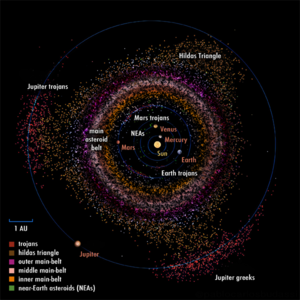
Back تعدين الكويكبات Arabic Explotació minera d'asteroides Catalan Těžba surovin z asteroidů Czech Asteroidenbergbau German Minería de asteroides Spanish Asteroididel kaevandamine Estonian استخراج سیارکی Persian Asteroidien louhinta Finnish Exploitation minière des astéroïdes French כריית אסטרואידים HE
This article has multiple issues. Please help improve it or discuss these issues on the talk page. (Learn how and when to remove these template messages)
|

Asteroid mining is the hypothetical extraction of materials from asteroids and other minor planets, including near-Earth objects.[1]
Notable asteroid mining challenges include the high cost of spaceflight, unreliable identification of asteroids which are suitable for mining, and the challenges of extracting usable material in a space environment.
Asteroid sample return research missions, such as Hayabusa, Hayabusa2, and OSIRIS-REx illustrate the challenges of collecting ore from space using current technology. As of 2023, less than 7 grams of asteroid material has been successfully returned to Earth from space.[2] In progress missions promise to increase this amount to approximately 60 grams (two ounces). Asteroid research missions are complex endeavors and return a tiny amount of material (less than 1 milligram Hayabusa, 100 milligrams Hayabusa2, 70 grams OSIRIS-REx) relative to the size and expense of these projects ($300 million Hayabusa, $800 million Hayabusa2, $1.16 billion OSIRIS-REx).[3][4]
The history of asteroid mining is brief but features a gradual development. Ideas of which asteroids to prospect, how to gather resources, and what to do with those resources have evolved over the decades.
- ^ O'Leary, B. (1977-07-22). "Mining the Apollo and Amor Asteroids". Science. 197 (4301): 363–366. Bibcode:1977Sci...197..363O. doi:10.1126/science.197.4301.363. ISSN 0036-8075. PMID 17797965. S2CID 45597532.
- ^ "The tale of 2 asteroid sample-return missions". cen.acs.org. Archived from the original on 2021-06-02. Retrieved 2021-05-30.
- ^ "Cost of OSIRIS-REx". The Planetary Society. Archived from the original on 2021-06-02. Retrieved 2021-05-31.
- ^ "NASA's OSIRIS-REx Achieves Sample Mass Milestone – OSIRIS-REx Mission". blogs.nasa.gov. 2023-10-20. Retrieved 2024-03-12.
© MMXXIII Rich X Search. We shall prevail. All rights reserved. Rich X Search